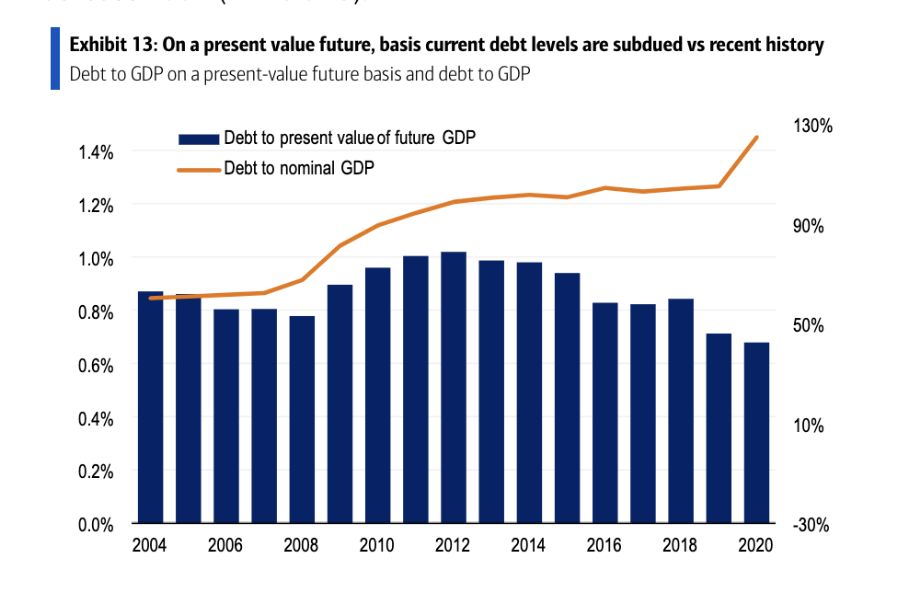
Bill Clark/CQ-Roll Call, Inc via Getty Images
- A Bank of America note says US government debt "is not that high" when measured correctly.
- If you value the US economy like a company, using a discounted cash flow analysis, the debt to GDP ratio is just 0.7%, the lowest since 2004.
- The bank cited research by former White House officials Larry Summers and Jason Furman, of Harvard.
- See more stories on Insider's business page.
The US national debt is measured at over $28 trillion, and for decades, it has been a source of concern – and inhibition – for lawmakers. The Republican Party tends to cite the runaway federal debt when it is not in possession of the White House, while Presidents Donald Trump and George W. Bush significantly addred to the debt when they held office.
But what if it's not actually that big, and the way of looking at it been wrong instead?
On Monday, a Bank of America Research team led by Jared Woodard questioned the accuracy of the traditional nation debt measurement, which compares federal debt to nominal gross domestic product. Instead, it suggested using a discounted cash flow, or DCF, analysis, which estimates the value of an investment based on expected future cash flows.
Using this method, which is how companies and financial assets are traditionally valued, the bank found the ratio of US federal debt to total GDP, defined as discounted future economic output of the entire US economy, comes in at 0.7%. That's the lowest since 2004. The traditional valuation method, on the other hand, shows that US federal debt as a percentage of GDP rose to 125% by the end of 2020.
"If we apply the same concepts used to value a company, and view the value of the US economy as the sum of the present values of future GDP, we can make an apples-to-apples comparison vs. debt," the report said.

BofA Research Investment Committee; Bloomberg; The Board of Trustees, Federal Old-Age and Survivors Insurance and Disability Insurance Trust Funds; Federal Reserve Bank of Philadelphia; Department of the Treasury
The bank cited a paper by Jason Furman, formerly President Barack Obama's chair of the Council of Economic Advisors, and Larry Summers, Obama's former Director of the National Economic Council, which discussed using DCF analysis as a more accurate way to measure the country's debt.
The paper by the economists, now both currently at Harvard, said that debt-to-GDP ratios "are a misleading metric of fiscal sustainability that do not reflect the fact that both the present value of GDP has risen and debt service costs have fallen as interest rates have fallen."
Last week, Federal Reserve Chairman Jerome Powell said US national debt will not be one of his main concerns in the near term, although he cited the traditional measurement that shows it growing rather than falling as a ratio.
"The US federal budget is on an unsustainable path, meaning simply that the debt is growing meaningfully faster than the economy," he said at a virtual event hosted by the Economic Club of Washington, DC. "The current level of debt is very sustainable. And there's no question of our ability to service and issue that debt for the foreseeable future."
Insider reported that US debt has spiked 200% since 2008 and risen by almost $8 trillion under former President Donald Trump, and stimulus programs have only served to accelerate the spike in debt.
But maybe that's looking at it the wrong way.